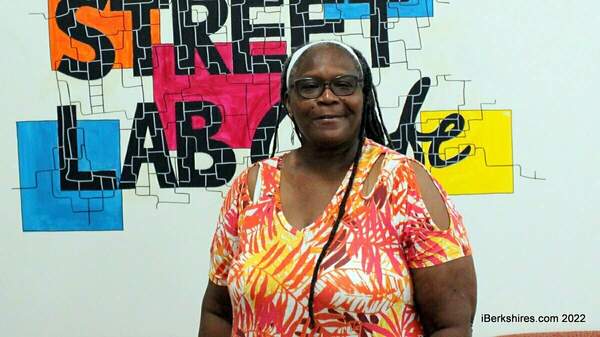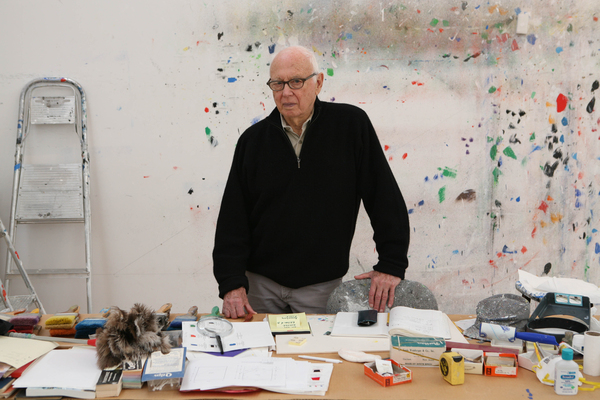
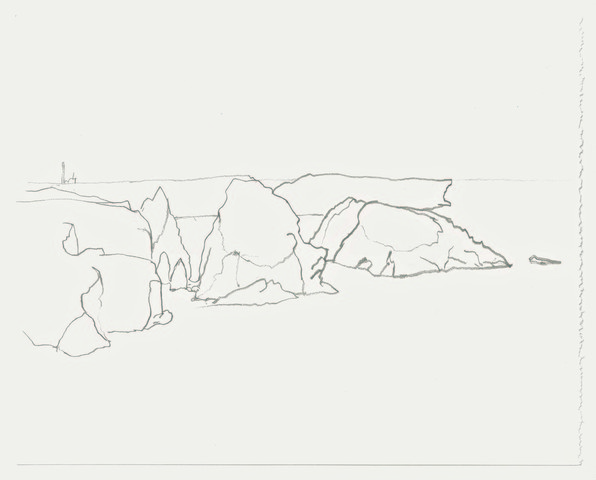
New Clark Exhibit Marries Contemporary, Traditional Art
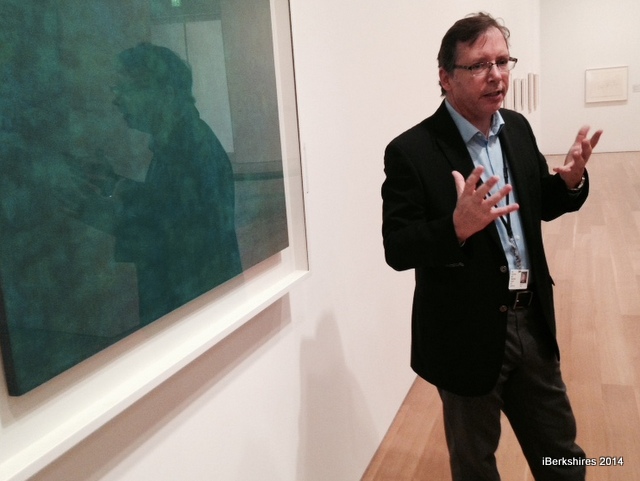 The Clark's senior curator, Richard Rand, speaks about Ellsworth Kelly's 'Tableau Vert,' a 1952 oil on wood that was inspired by a visit to the studio of French Impressionist painter Claude Monet. A new exhibit ties the French and American artists together. The Clark's senior curator, Richard Rand, speaks about Ellsworth Kelly's 'Tableau Vert,' a 1952 oil on wood that was inspired by a visit to the studio of French Impressionist painter Claude Monet. A new exhibit ties the French and American artists together. |
WILLIAMSTOWN, Mass. — The Clark Art Institute has been dipping a toe into contemporary art over the last few years. With the new exhibit "Monet | Kelly," the museum's entire foot is now officially submerged.
"Monet | Kelly," which opens to the public Sunday, Nov. 23, and runs through Feb. 15, features the work of American artist Ellsworth Kelly, who is 91 years old and lives nearby in Spencertown, N.Y. But Clark purists shouldn't worry: The exhibit considers the influence Impressionist painter Claude Monet had on Kelly and includes nine paintings by Monet himself — though they are not the paintings most people immediately associate with Monet.
The connection between Impressionist Monet and minimalist Kelly was not even immediately obvious to the Clark's senior curator, Richard Rand, who led a tour of the exhibit on Friday before its official opening. Rand said he had long wanted to work with Kelly but was a bit unsure when Kelly pitched this particular idea to him a couple years ago.
"When he brought this up, I couldn't quite fathom it in my head," he admitted. "But he said, 'No, no, it's very important, very interesting, and I think it would make a good project for the Clark,' because we are so rich in Impressionism, and Monet is one of our signature artists, and this would be just the right thing."
And sure enough, in working with Kelly, who Rand said was "very meticulous" in how he wanted his artwork displayed, the two connections became clear.
First, when Kelly was a young artist in the 1940s, he spent time in France. He became attracted to the Belle-Île, an island off the southern coast of Brittany, and sketched many simple but recognizable landscapes there. He discovered that Monet also had spent time painting on Belle-Île, and Kelly was drawn to the same locations Monet had visited.
"He was going to the actual locations that Monet had painted and made drawings on site," Rand said, emphasizing that he was not copying Monet's paintings. "He's drawing the site from the same vantage point that Monet had painted."
For that reason, one might assume the exhibit would be set up with the drawings and paintings side by side, but Rand said Kelly was not interested in that obvious juxtaposition.
|
|
"We talked a lot about, should we have the drawings and the paintings together or separate. In the end, he wanted them separate as their own thing," Rand said.
So in the first section of the exhibit, visitors will see the works by Monet chosen by Kelly to complement his own work: three from Belle-Île and six of the gardens at Giverny, Monet's home. In the second section, visitors are transitioned into works by Kelly, including the large abstract painting "Tableau Vert." The third section displays Kelly's sketches of Belle-Île from three separate trips: the original 1940s visit and two more recent visits, including one in 2013.
The second connection between the two artists, reflected in the Monet paintings of the Giverny gardens, tells a wonderful story of how deeply Monet influenced the path of Kelly's career. After leaving Belle-Île, Kelly returned to Paris and while developing his own abstract style, he began to collect reproductions of Monet's work. He met an art dealer who directed him to visit Giverny, Monet's studio, which at that time in the 1950s was not the tourist attraction it is now.
"At the time, no one knew about it," Rand said. "It was private. The gardens had all gone to seed; the house had gone decrepit. But all the late work was there."
That late work comprised stacks of paintings, many unfinished, that Monet had done while living out his final days at Giverny. It was an amazing discovery, and Monet's stepson and heir to the estate eventually gave the works to a French museum. Seeing all of those paintings of the gardens and the lily pond inspired Kelly's "Tableau Vert," a 1952 oil on wood that was a departure from his other works in that it had layers of green and brushed shades of blue, like water grass in a garden pond. Its creation surprised even the artist, Rand said.
"He didn't really quite understand what he was doing, because it was so unlike the work he was making at the time," Rand said, recalling Kelly's explanation of the painting: "I was trying to capture something of those grasses flowing under the water in Monet's garden."
Because he didn't understand the painting, he put it away for 30 years until he brought it back out by request for an exhibit and realized how it had been a turning point in his career.
"He realized suddenly the significance of the picture, that it was his first monochromatic painting he had ever made, and even though it's different in terms of its surface treatment from his flat color paintings, he recognized how transformational this was to his art, and it was a direct response to Monet's paintings at Giverny," Rand said.
And just as these Monet paintings are not as widely known as the more iconic work from his early years, so are the works by Kelly, many of which are on public display for the first time in this exhibit at the Clark.
"People who really know his art and have gone to visit him may have seen some of these, but these are all ... fresh and haven't been exhibited before," Rand said.
That just adds to the excitement of bringing together a classic French artist with a contemporary American one, Rand said.
"It's a perfect marriage between our traditional Impressionist bent at the Clark and our burgeoning interest in modern and contemporary art," he said. "It's a great marriage."
Admission to "Monet | Kelly" is $10.
Tags: Clark Art, exhibit,

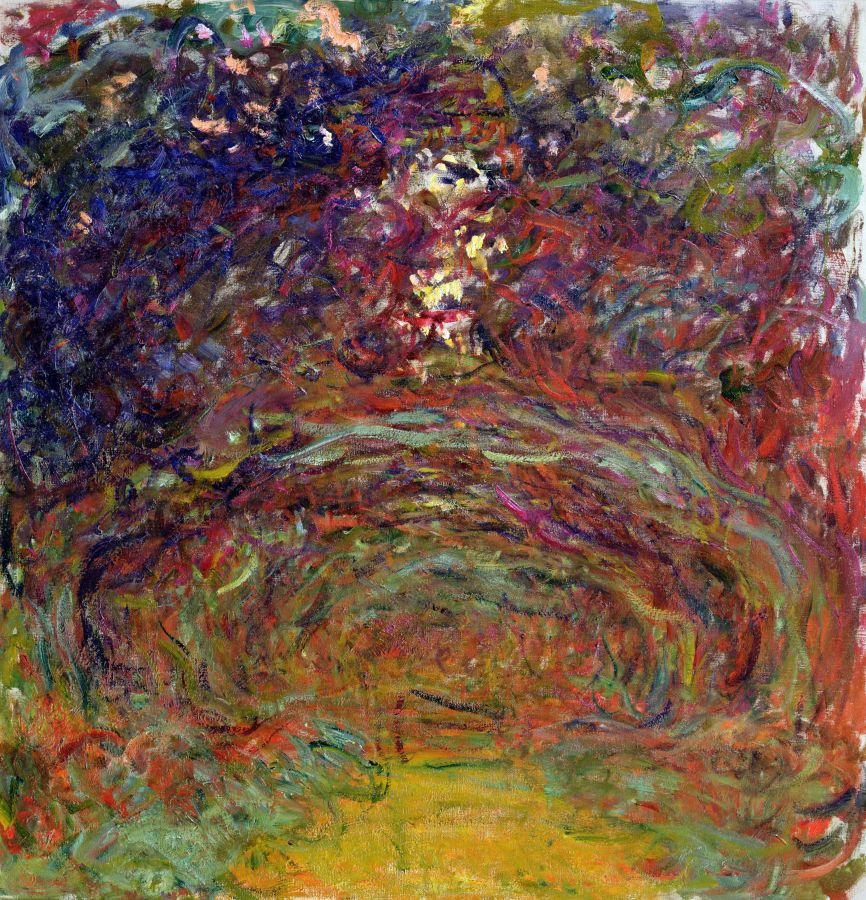 Claude Monet's 'The Path under the Rose Arches,' circa 1920–22, is one of the late Monet works that inspired American artist Ellsworth Kelly. The painting is on loan to the Clark Art Institute from the Musée Marmottan Monet, Paris.
Claude Monet's 'The Path under the Rose Arches,' circa 1920–22, is one of the late Monet works that inspired American artist Ellsworth Kelly. The painting is on loan to the Clark Art Institute from the Musée Marmottan Monet, Paris.



